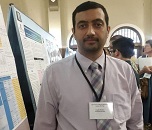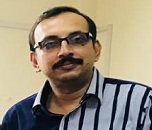Day 1 :
Keynote Forum
Ahmed Raza Khan
Australian National University, Australia
Keynote: Paper Title Monitoring Folds Localization in ultra-thin Transition Metal Dichalcogenides using Optical Harmonic Generation
Time : 9:45-10:30

Biography:
Abstract:
Keynote Forum
M Nazari
Materials and Energy Research Center (MERC), Iran
Keynote: An electronic nose for detection of n-Hexane based on QCM gas sensor array
Time : 10:00

Biography:
M.Nazari has completed her master at the age of 30 years from material and Energy Research Center University and PhD Studies from Nanoscience and Nanotechnology department, Aveiro University, Portugal. She is working on microfluidic sensors based on molecularly imprinted polymers for detection of marine toxins and toxic microalgae in her PhD thesis
Abstract:
Lung cancer is one the deadliest diseases in the world. Quartz crystal microbalance (QCM) is a novel mass sensitive sensor used a piezoelectric disc coated with a special material to detect targeted analytes. Various nano films have been coated with different techniques on its disk to increase sensitivity due of higher surface area available in nano-structural materials to identify lung cancer and get some elementary experimental results. QCM sensors are used to detect different VOCs which most of these VOCs are in the breath of lung cancer patients. N-Hexane is one of them that this present study investigated this gas. Polymer film technology is applied to improve the sensitivity of the QCM sensors. Herein, 7 polymers, PVP, PS, PA PVC, PU, PMMA, PC, were coated on the QCM electrode with electrospinning method. The sensor responses were linear and reproducible in the studied concentration ranges between 20ppm to 40 ppm. Electrospun nanofibers showed a superior frequency shift. The studied coatings have the capability to be used as simple and cost-effective layer for effective monitoring of n-Hexane vapor concentration in gaseous environments. In addition, based on PCA analysis for electrospun layers, it was shown that good separation can be achieved by using 5 polymer layers.
Keynote Forum
Ganesh Gollavelli
Jawaharlal Nehru Technological University, India
Keynote: Graphene Phototheranostics for Cancer and Bacterial Ablation
Time : 10:30

Biography:
Dr. Ganesh Gollavelli working as an Associate Professor in the dept. of HBS, Aditya Engineering College (Autonomous), Jawaharlal Nehru Technological University Kakinada, India from 2021. Previously he worked as an Assistant Professor at Addis Ababa Science and Technology University in Ethiopia (2018-2020). He has 3 years of Postdoctoral Research Fellow and Faculty experience from National Tsing Hua University (2012-14) and National Chiao Tung University (2016-17), Hsinchu, Taiwan. He obtained Ph.D. as an outstanding fellow from National Tsing Hua University, Taiwan (2012) and master's and BSc with distinction from Andhra University (2001-06). He worked as a Junior Research Fellow at IIT Madras, Chennai (2007-08). He secured publication awards and various national and international scholarships from well-reputed institutions. Published in ACS, RSC, Elsevier, Springer journals and filed US Patent. He is a Member of AAAS Science, ACS, Global water intelligence, and Synergy Publishers. Organizing member of international conferences and workshops. He attended many national and international conferences as a participant and invited speaker.
Abstract:
The development of nanotechnology and nanomedicine is expected to address numerous medical problems, particularly those related to cancer and infectious diseases, which are among the top five most lethal diseases in the world. The elimination of these issues by precise diagnosis and treatments is of major concern. When compared to more conventional therapeutic approaches like radiation therapy, chemotherapy, and surgery, near infrared mediated phototherapy is a non-invasive strategy utilized to infiltrate many chronic cancers and bacterial infections with minimal inflammation. For a better understanding of this area of study, I would like to share the most recent research on graphene phototheranostics here.1 Besides; I would like to explore my research work based on multifunctional grapheme (MFG) for diagnosis and phototherapy of cancer and bacteria. The MFG has synthesized to fulfill the idle characteristics of the theranostic probe, which could provide the multiple diagnosis and therapy with a single and minimal dosage within a short time. In order to prepare the MFG we adopted Hummers method and microwave followed by sonication to produce graphene oxide (GO), magnetic grapheme (MG) and MFG. The prepared MFG has a good magnetic and photoluminescence property. The fluorescent probe and the photosensitizers has functionalized by following covalent and noncovalent approaches. The well functionalized MFG has very good absorption in entire biological window (650-1300nm).2 To explore the outstanding features of the MFG, we have studied its biocompatibility in vitro and in vivo by using HeLa cells, zebrafish and mice. The experimental results have shown that the MFG is biocompatible and excellent luminescence inside the HeLa cells as well as in the zebrafish and mice. Apart from this we have explored its magnetic property for MRI imaging and provided very good concentration dependent contrast than clinically approved resovist. Interestingly, the broad absorption of MFG has given very good heat absorption curve while irradiation with 808 nm and 1064 nm NIR Lasers. Hence, we demonstrated its photothermal capability. The MFG was given very good results of photo in activation of cancer. It was confirmed by the HSP60 expression experiments.3 Apart from this the MFG has functionalized with SiNc4 a photo sensitizer which can generate the singlet oxygen upon irradiation of NIR light. The O1 generation character of MFG-SiNc4 has evaluated with singlet oxygen sensor green experiments. This dual nature of photothermal and photodynamic therapy by MFG-SiNc4 has given the synergistic killing efficacy than the bare MFG alone. Besides, we have also explored the photokilling efficacy of bacteria along with cancer cells and made a comparison between the 808 nm and 1064 nm laser irradiations as the MFG has a flat absorption in both the biological window ranges. We have observed that both the wavelengths has similar killing efficacy and 1064 has given some better results as this light has a better penetration into the cells.4-5
The multifunctional nanographene is utilized to identify diseases and is explored in relation to image-guided therapy in vitro. The in vivo imaging guided photo therapy has to explore further in tumor and bacteria bearing mice. Furthermore, obstacles and future prospects are carefully discussed here, along with the use of photothermal and photodynamic therapy to treat various malignancies and bacterial infections using multiple imaging and therapeutic models.
Keynote Forum
Gangaraju Gedda
Presidency University, India
Keynote: Medicinal Plant materials Derived Carbon dots for Therapeutic Applications
Time : 11:00

Biography:
Gangaraju Gedda is working as professor in the department of Chemistry, Presidency University, Bangalore, Karnataka, India
Abstract:
A variety of bio-active therapeutic agents attained from medicinal plants have assessed for their feasibility to cure various disease. Bioactive compounds such as phytochemicals containing natural sources (turmeric leaves, ginger, garlic, cannabis sativa leaf, Aloe-Vera extract) derived CDs showed various therapeutic properties such as anti-cancer, anti-oxidant, anti-fungal, anti-bacterial, anti-diabetic and anti-inflammatory. However, the extraction of bioactive components from plant materials not only involve complicate synthesis and purification steps but also it involves expensive and toxic chemical/solvents. Therefore, it essential to develop novel, green and economical methods for the preparation of effective therapeutic agents. Recently carbon dots (CDs) gained remarkable attention due to their due to their nanosize, low toxicity, excellent biocompatibility water solubility and remarkable free radicals scavenging properties. It was noticed that the physical, chemical and biological properties mainly depend on the selection of carbon precursors for the CDs preparation. It is worthy and emergent to prepare CDs dots from bioactive compounds containing medicinal plants and evaluating their therapeutic properties. Here, we discussed about synthesis, properties and therapeutic applications of CDs derived from medicinal plant materials.
Keynote Forum
Neha Agarwal
University of Lucknow,India
Keynote: Current Trends in Nanocatalysis for Green Environment and its Applications

Biography:
Dr. Neha Agarwal is currently working as Head, Department of Chemistry, Navyug Kanya Mahavidyalaya (University of Lucknow), India. She had completed her Ph.D. in the year 2017, from the University of Lucknow under the theme “ Kinetic and Mechanistic Investigations of Some Electron Transfer Processes”. The core area of research work was based on the Kinetic study of oxidation of Pharmaceuticals, identification of end products and their future impacts on environment. She has qualified UGC-CSIR-NET Chemical Science and GATE-Chemical Science. Research publications include twelve research papers in journals of National and International repute. Authored many book chapters focused on the current and future prospects of Higher Education & Technological advancements post COVID 19. She is the Chief Editor of the book “Chemistry of Health, Hygiene and Environment”. She has Presented work in many National - International seminars and conferences as an invited speaker.
Abstract:
In the current times we are confronting with the issues related to environment, atmosphere, and energy. Catalytic discoveries could provide appropriate solutions using environmentally friendly chemicals and materials. With the advancement of nanotechnology, there has been a tremendous transformation in research, especially in nano-based advanced catalytic activities. The utility of nanocatalysts has drawn attention across the globe in creating greener environments. Due to their tiny size and larger surface area, nano-catalysts provide a better interface and expanded functionality. There has been a dramatic increase in research in the area of nano-catalysis with a special focus on the study of nano-size on their catalytic properties. This has led to a paradigm shift towards the greener catalytic applications of nanomaterials with greater activity and high selectivity. Nano-catalysis, being affordable and eco-friendly in nature, is turning into a popular field of scientific studies. Therefore, there is a great need to comprehend the remarkable and brilliant properties of nanocatalysts and their applications. For a green environment, researchers must focus on the catalytic applications of nanomaterials in day-to-day life, to reduce the environmental impacts of waste, and other explicit properties of nanomaterials due to size and structure at the nano level.
Keynote Forum
Hayder Alalwan
Middle Technical University, Iraq
Keynote: Spectroscopic Investigation of Metal oxide Nanoparticles reduction Mechanism in CLC process
Time : 12:00

Biography:
Dr. Hayder Alalwan is has a PhD in chemical and biochemical engineering from The University of Iowa –USA and is currently serve as the head of Petrochemical Techniques Dept., at the Middle Technical University-Iraq. His research focus on using nanoparticles in different applications such as adsorption, water treatment, catalysis, and oxygen carriers for carbon captures. He has more than 34 published manuscript
Abstract:
Transition metal oxide nanoparticles were used as oxygen carriers chemical looping combustion (CLC), a promising indirect combustion process that facilitates carbon capture. The focus of the investigation was to identify the reduction mechanism of the transition metal oxides during CLC using a continuous flow through system and spectroscopic, microscopic, and thermo gravimetric analysis. The comparison of the reactivity of copper (CuO), iron (α-Fe2O3) and cobalt (Co3O4) oxides with methane (CH4) in CLC reveals a link between the solid-state reduction mechanism of CLC oxygen carriers and their size-dependent reactivity toward CH4. The results show that the reactivity of CuO and Co3O4 are independent of the particle size, with reduction following the nucleation and nuclei growth (NNG) model, whereas α-Fe2O3 shows increased reactivity with decreasing particle size and reduction follows the unreacted shrinking core (USC) model. Supported by density functional theory (DFT) calculations comparing relative energies of formation for surface and bulk oxygen defects, we propose a conceptual framework for the size-dependence of metal oxide oxygen carriers for CLC. For oxygen carriers that reduce via the NNG model, where reduction initiates within the particle core, there will be no size dependence. For reduction via the USC model, where reduction initiates on the particle surface, reactivity will increase for smaller particles. These findings can guide development of metal oxide oxygen carriers for CLC by establishing trends in size-dependent behavior.
Keynote Forum
Soha Nayyar
Gov. College Women University, Pakistan
Keynote: The Biogenic Synthesis of Cobalt Monometallic and Cobalt Zinc Bimetallic Nanoparticles Using Cymbopogan citratus L. Leaf Extract and Assessment of Their Activities as Efficient Dye Removal and Antioxidant Agents

Biography:
Soha Nayyar has completed her MPhil at the age of 24 years from the Government College Women University, Sialkot. She is a lecturer in The Shahbaz Academy of Sciences. Her area of expertise is Nanotechnology. Her most recent publication was “The Biogenic Synthesis of Cobalt Monometallic and Cobalt Zinc Bimetallic Nanoparticles Using Cymbopogan citratus L. Leaf Extract and Assessment of Their Activities as Efficient Dye Removal and Antioxidant Agents”
Abstract:
In this work, green synthesized cobalt monometallic and cobalt–zinc bimetallic NPs were prepared by bioreduction of metallic salts with Cymbopogan citratus plant extract. Biosynthesized cobalt nanoparticles (NPs) and cobalt–zinc bimetallic NPs were characterized using diverse techniques such as FTIR, UV-Visible spectroscopy, SEM, XRD, and EDX analyses. UVvisible spectra for green-synthesized cobalt monometallic and cobalt–zinc bimetallic NPs were in the range between 300 to 350 nm, which confirmed the formation of stable monometallic and bimetallic NPs. The average particle size of CoNPs calculated by XRD analysis was found to be 22.77 nm and that of Co-Zn BMNPs was 14.8 nm. Different functional groups in the Cymbopogan citratus plant extract, which served as a reducing and stabilizing agent for NPs, were identified by FTIR spectra. Cobalt NPs and cobalt–zinc bimetallic NPs were used in the evaluation of antioxidant, anti-inflammatory, and dye degradation activity. Green-synthesized cobalt monometallic NPs and cobalt–zinc bimetallic NPs exhibited excellent antioxidant activity with the scavenging of DPPH free radicals. Green synthesized cobalt NPs and cobalt–zinc bimetallic NPs were utilized for the removal of methylene blue (MB) dye. Different parameters such as the effect of temperature, pH, and dye concentration on adsorbent doses were analyzed and optimized. The best dye removal percentage was obtained with Co-Zn BMNPs compared with CoNPs. Cobalt NPs and cobalt–zinc bimetallic NPs did not display good anti-inflammatory activity because of the presence of secondary metabolites which inhibited them to react with proteins.
Keynote Forum
SABU THOMAS
Mahatma Gandhi University, India
Keynote: Engineering at the Nanoscale: A Strategy for Developing High Performance Functional Materials from Biopolymers

Biography:
Sabu Thomas is currently the Vice-Chancellor of Mahatma Gandhi University, Kottayam, Kerala, India. He is a Professor at the International and Inter University Centre for Nanoscience and Nanotechnology and Full Professor of Polymer Science and Engineering at the School of Chemical Sciences of Mahatma Gandhi University, Kottayam, Kerala, India. His ground-breaking research has covered the areas of polymer science and engineering, polymer nanocomposites, elastomers, polymer blends, interpenetrating polymer networks, polymer membranes, green composites and nanocomposites, nanomedicine and green nanotechnology. Prof. Thomas has received several national and international awards in recognition for his work, and recently received Honoris Causa (DSc) from the University of South Brittany, Lorient, France, in recognition for his contributions to polymer science and engineering. Prof. Thomas has published over 1400 peer- reviewed research papers, reviews and book chapters. He has co-edited more than 175 books. Currently he is having an H index of 127.
Abstract:
Green chemistry started for the search of benign methods for the development of nanoparticles from nature and their use in the field of antibacterial, antioxidant, and antitumor applications. Bio wastes are eco-friendly starting materials to produce typical nanoparticles with well-defined chemical composition, size, and morphology. Cellulose, starch, chitin and chitosan are the most abundant biopolymers around the world. Cellulose nanoparticles (fibers, crystals and whiskers) can be extracted from agrowaste resources. Chitin is the second most abundant biopolymer after cellulose, it is a characteristic component of the cell walls of fungi, the exoskeletons of arthropods and nanoparticles of chitin (fibers, whiskers) can be extracted from shrimp and crab shells. Starch nano particles can be extracted from tapioca and potato wastes. These nanoparticles can be converted into smart and functional biomaterials by functionalization through chemical modifications due to presence of large amount of hydroxyl group on the surface. The preparation of these nanoparticles includes both series of chemical as well as mechanical treatments; crushing, grinding, alkali, bleaching and acid treatments. Since large quantities of bio wastes are produced annually, further utilization of cellulose, starch and chitins as functionalized materials is very much desired. The cellulose, starch and chitin nano particles are currently obtained as aqueous suspensions which are used as reinforcing additives for high performance environment-friendly biodegradable polymer materials. These nanocomposites are being used as biomedical composites for drug/gene delivery, nano scaffolds in tissue engineering and cosmetic orthodontics. The reinforcing effect of these nanoparticles results from the formation of a percolating network based on hydrogen bonding forces. The incorporation of these nano particles in several bio-based polymers have been discussed. The role of nano particle dispersion, distribution, interfacial adhesion and orientation on the properties of the ecofriendly bio nanocomposites have been carefully evaluated.
Keynote Forum
Iseult Lynch
University of Birmingham, UK
Keynote: Environmental Nanoscience
Time : 9:30

Biography:
Iseult Lynch is a professor and chair in the University of Birmingham, UK. She was senior Lecturer till 2016.
Abstract:
Will update soon...
Keynote Forum
Subhasis Roy
University of Calcutta, India
Keynote: Perovskite Nanomaterials for eco-friendly and stable solar cell applications

Biography:
Subhasis Roy is working as Assistant Professor at Department of Chemical Engineering,University of Calcutta, India. Dr. Roy received Ph.D. from Indian Institute of Technology, Kharagpur, India, in 2012. Before joining as a faculty member at Calcutta University, he worked as a Postdoctoral Researcher at Sungkyunkwan University, South Korea, Research Scientist at IISER, Kolkata, and worked as a visiting researcher Raman Fellow Ohio University. Dr. Roy has published more than 65 scientific research papers in peer-reviewed journals 35 conference proceedings. He has 15 book chapters to his credit and filed several patents. Dr. Roy was awarded DST-Fast Track Young Scientist Start-Up Research Grant from SERB –DST, Mission innovation MI IC#5' DBT-DST joint funding grant, Teachers Associateship for Research Excellence (TARE) SERB –DST. He holds members of many professional societies such as Royal Society of Chemistry (MRSC), National Academy of Sciences, India (NASI), reviewers, and editorial board member of many international journals. His expertise is in perovskite solar cells, multiferroic composite thin films, photocatalysts for water splitting, fuel cells, and hydrogen energy.
Abstract:
Developing thin film-based perovskite solar cells is on the lab scale by considering crucial factors, including degradation, instability, and toxicity, which are undesirable for perovskite photovoltaic technology. In the case of perovskite solar cells, we worked on the controlled processing of nanostructured films for environment-friendly renewable energy sources. In this case, we successfully synthesized nanocrystals by hydrothermal process. The structure and morphology of all hybrid nanoparticles were characterized using a range of techniques such as X-ray diffraction, electron microscope, optical spectroscopic measurements. Several attempts have been made to improve the efficiency of the thin-film solar cell by the change of the fabrication process and optimizing environment-friendly materials addition. Several research works have been carried out under different experimental conditions towards the development of lead (Pb) free, environment-friendly and green perovskite solar cells, along with introducing a new, facile and effective method to develop stable and efficient perovskite solar cell at ambient condition. Fabricated solar cells were tested under different characterization techniques to explore the optical behavior, structural fundamentals, crystallinity, surface morphology, phase formation, defect and disorder, and electrical properties.
Keynote Forum
Sanjib Bhattacharya
University of North Bengal, India
Keynote: A Broad Aspect of Glass-Nanocomposites: Journey from Ionic Conductors to Chalcogenide Glassy Alloys

Biography:
SANJIB BHATTACHARYA is working Associate Professor-Deputy Director, UGC-Human Resource Development Centre, Adjunct Faculty, Department of Physics, University of North Bengal, India. He was an Assistant Professor in Physics, Siliguri Institute of Technology, Siliguri, WB (2010-2020) Sr. Lecturer in Physics, Institute of Engineering and Management, Kolkata, WB (2009-2010) He was Lecturer in Physics, Dream Institute of Technology, Kolkata, WB (2007-2009) JRF & SRF in the Solid State Physics Department, INDIAN ASSOCIATION FOR THE CULTIVATION OF SCIENCE, Kolkata (2003-2007) Qualification: MSc (Physics) from University of North Bengal, 2002 Highest Qualification: PhD (Science) from INDIAN ASSOCIATION FOR THE CULTIVATION OF SCIENCE AND JADAVPUR UNIVERSITY, WB, 2008. He have13 years Teaching Experiences in Engineering Physics, Materials Science and Solid State Devices and 17 years Research Experience.
Abstract:
Physical properties like density and molar volume of some as-prepared glass-nanocomposites (Ionic System) provide an insight into the atomic arrangements. The variation of density with the compositions may cause gradual change of non-bridging oxygen which is consistent with the infrared spectroscopic results. Impurity or transition metal ions doped chalcogenide glassy system showed that the electrical conduction mechanism predominated by hoping of small polarons. To explore the conduction mechanism in chalcogenide semiconductors, the study of frequency dependent electrical conductivity is very much essential not only for practical applications but also for academic interest. A complete description on electrical transport phenomenon and dielectric relaxation of such glassy system is still pending till date because lack of their micro-structural information and approximation in data analysis. The AC conductivity and dielectric behaviour of them have been studied. X-ray diffraction (XRD) has been used as probe to reveal microstructure of them. The motivation of the present communication is to study composition dependent electrical and dielectric properties of some Ionic, Semiconducting and Chalcogenide glassy system. The results may open the way to the preparation, application and investigation of significant electrical and dielectric properties of such systems.
Keynote Forum
Marwa Ben Chobba
University of Sfax, Tunisia
Keynote: Ag-doped TiO2 nanoparticles as self-cleaning and antimicrobial agent: synthesis, characterization and use with PDMS as a nanocomposite protective coating.
Time : 12:30

Biography:
She is working as intern in the Laboratory of Advanced Materials, National School of Engineering, University of Sfax, Sfax, Tunisia.
Abstract:
Water induces several deterioration mechanisms in porous stone materials. In addition to physical and chemical decay processes, water is essential for the growth of biodeteriogens, whose growth contributes to the stone artworks decay. Different approaches have been developed to protect heritage materials. Particularly, using nanomaterials exhibiting selfcleaning features has been considered an interesting and economical method to conserve valuable heritage material surfaces. TiO2 nanoparticles (NPs) have been extensively used for self-cleaning applications, particularly, cleaning and preventing colonization of heritage building surfaces. This study focuses on developing hydrophobic thin films to be used as protective coatings. The effects of NPs (TiO2) concentration in the binder matrix was evaluated and different mixtures were applied to the Lecce stone surfaces. The more suitable doping amount range was assessed based on chromatic variations and contact angle measurements. Next, the optimal formulations of Ag-doped TiO2 NPs mixed with PDMS as self-cleaning protective coatings were evaluated by different experimental analyses: colourimetric and static contact angle measurements, water capillary absorption and water vapour permeability tests. The microstructural and morphological features of thin films were investigated by optical microscope and SEM-EDS analyses. The mechanical properties of protective coatings were evaluated through Vickers microhardness and pencil hardness tests. Moreover, the self-cleaning properties of the coatings were evaluated by performing the photo-degradation test (MB used as an organic pollutant) and biological experiments were evaluated against a stabilized mixture composed of five microbial strains isolated from biodeteriorated building materials. The durability of the developed nanocomposite coatings was assessed after exposure to different ageing cycles (solar light, high humidity, and long-term microbial incubation.
